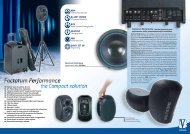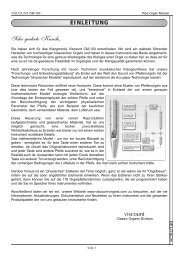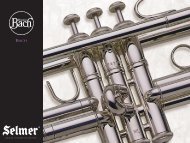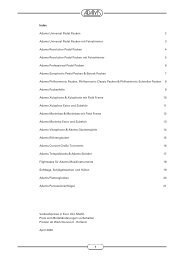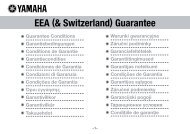CM100 Advanced Manual (GB).pdf (1.347,89kb) - Viscount ...
CM100 Advanced Manual (GB).pdf (1.347,89kb) - Viscount ...
CM100 Advanced Manual (GB).pdf (1.347,89kb) - Viscount ...
Create successful ePaper yourself
Turn your PDF publications into a flip-book with our unique Google optimized e-Paper software.
VISCOUNT CM-100<br />
Pipe Organ Module<br />
For each voice, the system is able to set an output configuration which reflects the layout of the pipes in<br />
real wind-chests, as follows:<br />
Wedge<br />
Chromatic<br />
Left Wing<br />
Right Wing<br />
Mono<br />
Alternate Keys<br />
Moreover, each of these layouts can be further specified with regard to the width of the wind-chest and<br />
its central location in relation to the number of outputs connected.<br />
It is important to underline that the system automatically adapts the channelling to the number of<br />
speakers connected.<br />
3.4.1 Short introduction to the Windchest W<br />
of pipe organs<br />
The wind-chest is a box in which the air from a bellows is distributed. The bellows may be operated by<br />
hand or an electric motor, and keeps the air pressurised and ensures it is uniformly distributed through<br />
the pipes.<br />
Normally, each manual has its own wind-chest which contains the pipes.<br />
However, there are various types of wind-chest, which may contain a single register or have a cascade<br />
arrangement with an organ valve (a box full of air filled by the bellows) with the branches leading off to<br />
all the registers for each note.<br />
The following is a short description of the wind-chests which the CM-100 simulates:<br />
<br />
Wedge<br />
In this configuration, the tallest, broadest pipes are located in the centre, so the voice's<br />
lowest notes are played by the most central speakers. As the pitch rises the signal is<br />
gradually distributed further and further to the outside, in alternation; in other words,<br />
C will sound on the right and C# on the left.<br />
<br />
Chromatic<br />
This configuration is the opposite of the previous one; in this mode, the tallest,<br />
broadest pipes are on the outside, so the lowest notes are played on the outermost<br />
speakers, again in alternation. As the pitch rises the notes are played closer and<br />
closer to the centre.<br />
<br />
Left Wing<br />
As the the drawing shows, the tallest, broadest pipes are installed on the left, so the<br />
lowest notes are played by the speakers furthest to the left. As the pitch rises the notes<br />
are played more and more to the right.<br />
ENGLISH<br />
Page 18



